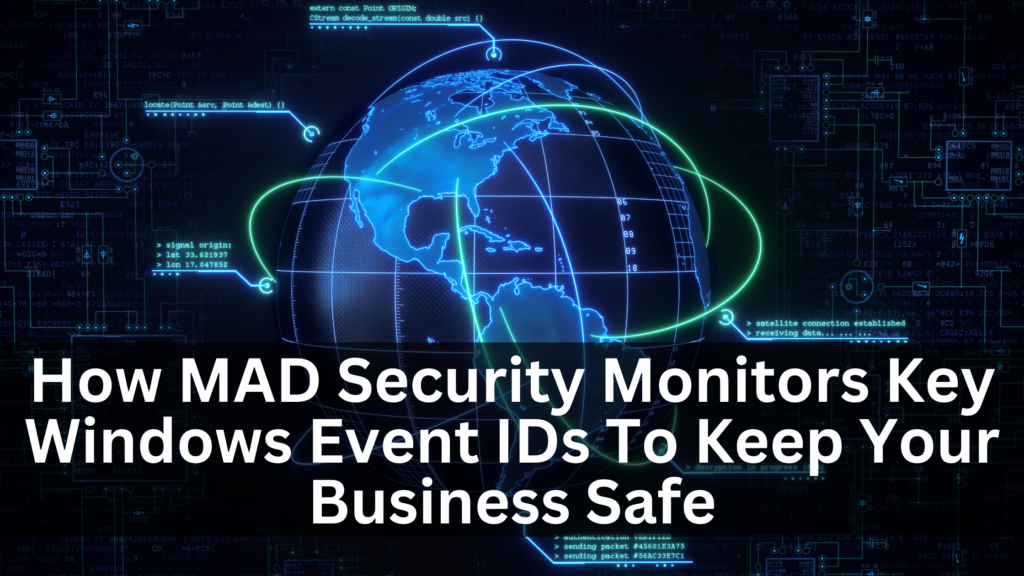
Using Windows Events IDs During Cybersecurity Monitoring
Cybersecurity threats are becoming increasingly sophisticated, making it crucial for businesses to take a proactive approach to cybersecurity monitoring to protect their systems and data. One of the ways this can be done is by monitoring key Windows event IDs to detect malicious activity and respond quickly to keep your business safe. This post will explain what specific events MAD Security monitors and provide context examples to understand these events’ significance better.
The Importance of Cybersecurity Monitoring
 Businesses increasingly rely on technology to run their operations in today’s digital world. From storing sensitive data to conducting transactions, a business’s success is directly tied to its ability to secure its systems and data. Unfortunately, the more reliant a business becomes on technology, the more vulnerable it becomes to cyber attacks. Hackers are constantly seeking new ways to penetrate systems and steal sensitive information. This makes it essential for businesses to take a proactive approach to cybersecurity.
Businesses increasingly rely on technology to run their operations in today’s digital world. From storing sensitive data to conducting transactions, a business’s success is directly tied to its ability to secure its systems and data. Unfortunately, the more reliant a business becomes on technology, the more vulnerable it becomes to cyber attacks. Hackers are constantly seeking new ways to penetrate systems and steal sensitive information. This makes it essential for businesses to take a proactive approach to cybersecurity.
The Power of Windows Event IDs
 Windows event IDs contain a wealth of information about the activity on a Windows system. By monitoring the following key event IDs, MAD Security can detect and respond to malicious activity:
Windows event IDs contain a wealth of information about the activity on a Windows system. By monitoring the following key event IDs, MAD Security can detect and respond to malicious activity:
- 4624: An account was successfully logged on.
- 4625: An account failed to log on.
- 4648: A logon was attempted using explicit credentials.
- 4768: A Kerberos authentication ticket (TGT) was requested.
- 4776: The domain controller attempted to validate the credentials for an account.
- 4740: A user account was locked out.
- 5061: A Windows Firewall setting has changed.
- 1102: The audit log was cleared.
- 4688: A new process has been created.
- 5157: The Windows Filtering Platform has permitted a bind to a local port.
Examples of Windows Event ID Monitoring
To effectively detect malicious activity, MAD Security must understand the context in which these events occur. Here are a few examples of how context helps to detect and respond to cyber attacks:
- A large number of successful logons (Event ID 4624) occurring from a single IP address within a short time frame could indicate a brute-force attack.
- A large number of TGT requests (Event ID 4768) occurring from a single IP address within a short time frame could indicate a Kerberoasting attack, where an attacker is trying to retrieve user account passwords in clear text.
- A high number of failed logons (Event ID 4625) from a single IP address over an extended period of time could indicate an attempted dictionary attack.
- An unexpected change to the Windows firewall settings (Event ID 5061) could indicate that an attacker has gained access to the system and is attempting to bypass security measures.
Knowing what is normal activity and what is not is critical to detecting and responding to cyber-attacks. MAD Security uses its expertise, experience, and the latest technology to identify patterns of behavior that indicate malicious activity. We then use this information to develop responses that minimize the attack’s impact on your business.
Trust MAD Security for your business’s Cybersecurity Needs
MAD Security provides continuous cybersecurity monitoring and protection against malicious activity, quick detection and response to security threats, access to expert security knowledge and resources, and cost savings compared to building an in-house security team. MAD Security is staffed by experienced cybersecurity professionals trained to respond to security threats and have the latest technology and tools at their disposal. Trusting MAD Security to monitor key Windows event IDs is a smart investment for your business and essential to keeping your systems and data secure.
About MAD Security
With 24/7/365 monitoring, MAD Security seamlessly maintains full visibility across your network and cloud environments, mitigate threats, and curb attacks in real time – effectively protecting your systems and granting invaluable peace of mind.
Our certified cybersecurity specialists leverage cutting-edge technologies to provide 24/7/365 continuous monitoring, network security, endpoint detection, and more to curb threats before they manifest as attacks.
Contact us to learn more!

